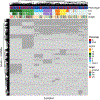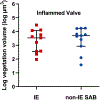All Staphylococcus aureus bacteraemia-inducing strains can cause infective endocarditis: Results of GWAS and experimental animal studies
- PMID: 36603774
- PMCID: PMC10399548
- DOI: 10.1016/j.jinf.2022.12.028
All Staphylococcus aureus bacteraemia-inducing strains can cause infective endocarditis: Results of GWAS and experimental animal studies
Abstract
Objectives: We aimed at determining whether specific S. aureus strains cause infective endocarditis (IE) in the course of Staphylococcus aureus bacteraemia (SAB).
Methods: A genome-wide association study (GWAS) including 924 S. aureus genomes from IE (274) and non-IE (650) SAB patients from international cohorts was conducted, and a subset of strains was tested with two experimental animal models of IE, one investigating the early step of bacterial adhesion to inflamed mice valves, the second evaluating the local and systemic developmental process of IE on mechanically-damaged rabbit valves.
Results: The genetic profile of S. aureus IE and non-IE SAB strains did not differ when considering single nucleotide polymorphisms, coding sequences, and k-mers analysed in GWAS. In the murine inflammation-induced IE model, no difference was observed between IE and non-IE SAB strains both in terms of adhesion to the cardiac valves and in the propensity to cause IE; in the mechanical IE-induced rabbit model, there was no difference between IE and non-IE SAB strains regarding the vegetation size and CFU.
Conclusion: All strains of S. aureus isolated from SAB patients must be considered as capable of causing this common and lethal infection once they have accessed the bloodstream.
Keywords: Bacteraemia; Experimental animal model; Genome-wide association study; Infective endocarditis; Staphylococcus aureus.
Copyright © 2023 The Authors. Published by Elsevier Ltd.. All rights reserved.
Conflict of interest statement
Declaration of Competing Interest FV reports research funding outside the scope of the present study by bioMérieux, two patents pending in antimicrobial resistance detection and shares in Weezion. VGF reports personal fees from Novartis, Novadigm, Durata, Debiopharm, Genentech, Achaogen, Affinium, Medicines Co., Cerexa, Tetraphase, Trius, MedImmune, Bayer, Theravance, Basilea, Affinergy, Janssen, xBiotech, Contrafect, Regeneron, Basilea, Destiny, Amphliphi Biosciences. Integrated Biotherapeutics; C3J, grants from NIH, MedImmune, Cerexa/Forest/Actavis/Allergan, Pfizer, Advanced Liquid Logics, Theravance, Novartis, Cubist/Merck; Medical Biosurfaces; Locus; Affinergy; Contrafect; Karius; Genentech, Regeneron, Basilea, Janssen, from Green Cross, Cubist, Cerexa, Durata, Theravance; Debiopharm, Royalties from UpToDate; and a patent pending in sepsis diagnostics.
Figures






Comment in
-
External validation of multiple prognosis scores to guide usage of echocardiography in patients with Staphylococcus aureus bacteremia using a prospective cohort.J Infect. 2023 Sep;87(3):e45-e47. doi: 10.1016/j.jinf.2023.06.003. Epub 2023 Jun 18. J Infect. 2023. PMID: 37339684 No abstract available.
References
-
- Rhee Y, Aroutcheva A, Hota B, Weinstein RA, Popovich KJ. Evolving epidemiology of Staphylococcus aureus bacteremia. Infect Control Hosp Epidemiol 2015;36(12):1417–22. - PubMed
-
- Mylonakis E, Calderwood SB. Infective endocarditis in adults. N Engl J Med 2001;345(18):1318–30. - PubMed
-
- Baddour LM, Wilson WR, Bayer AS, Fowler VG, Tleyjeh IM, Rybak MJ, et al. Infective endocarditis in adults: diagnosis, antimicrobial therapy, and management of complications: a scientific statement for healthcare professionals from the American Heart Association. Circulation 2015;132(15):1435–86. - PubMed
Publication types
MeSH terms
Grants and funding
LinkOut - more resources
Full Text Sources
Medical

